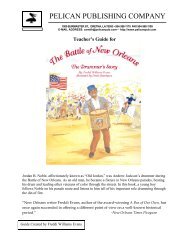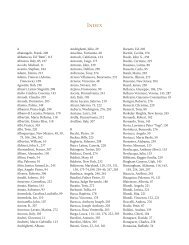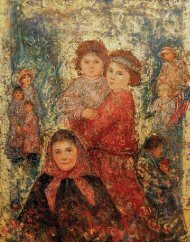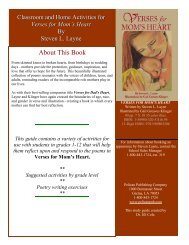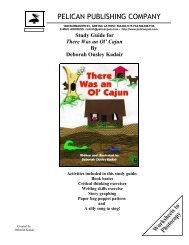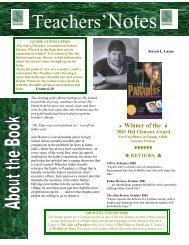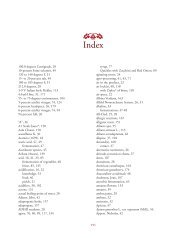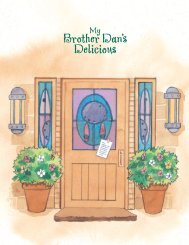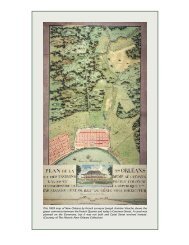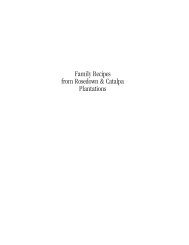tdt1e01.indd 14 3/13/2009 4:06:38 PM - Pelican Publishing Company
tdt1e01.indd 14 3/13/2009 4:06:38 PM - Pelican Publishing Company
tdt1e01.indd 14 3/13/2009 4:06:38 PM - Pelican Publishing Company
Create successful ePaper yourself
Turn your PDF publications into a flip-book with our unique Google optimized e-Paper software.
<strong>tdt1e01.indd</strong> <strong>14</strong><br />
3/<strong>13</strong>/<strong>2009</strong> 4:<strong>06</strong>:<strong>38</strong> <strong>PM</strong>
Chronology of Significant Events<br />
1835 Notorious Reconstruction outlaw Cullen Montgomery<br />
Baker was born near the Obion River, Weakley County,<br />
Tennessee.<br />
1840 Benjamin Bickerstaff, Reconstruction outlaw, was<br />
born near Gray Rock, Titus County, Texas.<br />
1844 Thomas Orr, the nemesis of Cullen Montgomery<br />
Baker, was born in Henry County, Georgia.<br />
1851 Lampasas, Texas, feudist Pink Higgins was born in<br />
Macon, Georgia (March 28).<br />
1853 John Wesley Hardin was born at Blair’s Springs, near<br />
Bonham, Texas.<br />
1854 Cullen Montgomery Baker killed his first victim near<br />
Forest Home, Texas.<br />
1857 The Higgins and Horrell families migrated to<br />
Lampasas, Texas within months of each other.<br />
1865 Union general Gordon Granger declared<br />
emancipation for Texas slaves (June 19).<br />
1867 The Baker gang ambushed a Federal soldier and<br />
teamster (October 6). James Miller, one of the most<br />
15<br />
<strong>tdt1e01.indd</strong> 15<br />
3/<strong>13</strong>/<strong>2009</strong> 4:<strong>06</strong>:<strong>38</strong> <strong>PM</strong>
16 Ten Deadly Texans<br />
notorious assassins in the West, was born eighteen days<br />
later in Van Buren, Arkansas.<br />
1868 A reward was posted for Cullen Baker, who reciprocated<br />
with a Wanted Dead or Alive poster offering a $5,000<br />
reward for Arkansas governor Clayton (September).<br />
Reconstruction official John Kirkman was assassinated at<br />
Boston, Texas, by persons unknown (October 7). Cullen<br />
Baker was among the chief suspects.<br />
Wild Bill Longley was hanged for the first time in northeast<br />
Texas but rescued by a brother of his associate Tom Johnson,<br />
who did not survive the lynching.<br />
1869 Cullen Montgomery Baker was assassinated near<br />
present-day Doddridge, Arkansas (January).<br />
The outlaw Bob Lee was killed (May 24).<br />
1871 Hardin killed Pt. Jim Smalley near Waco after being<br />
arrested for murder (January 22). He also killed Charles<br />
Cougar in Abilene, Kansas, supposedly for snoring (August) and<br />
freedman Green Paramore of Gonzales, Texas (October 6).<br />
1873 Mart, Tom, and Merritt Horrell killed three state<br />
policemen and mortally wounded a fourth while resisting<br />
arrest at Scott’s Saloon in Lampasas (March <strong>14</strong>).<br />
Hardin killed Irishman James B. Morgan in a bar fight at<br />
Cuero (April).<br />
Sutton factionist Jack Helm was killed by John Wesley<br />
Hardin and Jim Taylor at Albuquerque, sometime between<br />
March 1 and July 31.<br />
<strong>tdt1e01.indd</strong> 16<br />
3/<strong>13</strong>/<strong>2009</strong> 4:<strong>06</strong>:<strong>38</strong> <strong>PM</strong>
Chronology of Significant Events 17<br />
1874 William Sutton, supposed agitator of the Sutton-<br />
Taylor feud, was assassinated with his associate Gabe<br />
Slaughter by Taylor factionists as the pair boarded a<br />
steamboat at Indianola, Texas (March 11).<br />
1875 Accused cattle rustlers and cousins Pete and Lige<br />
Baccus were hanged by vigilantes near Mason on February<br />
18.<br />
Bill Longley killed William Anderson in revenge for the<br />
death of Longley’s cousin in Evergreen, Texas, or so the<br />
story goes (April 1).<br />
Tim Williamson, friend and mentor of former Texas<br />
Ranger Scott Cooley, was murdered on May <strong>13</strong>, prompting<br />
Cooley to begin the Mason County War by killing and<br />
scalping former deputy sheriff John Worley (Wohrle) on<br />
August 10. Karl Bader was killed nine days later by Cooley<br />
associates.<br />
Leading Taylor factionist Jim Taylor was assassinated<br />
at Clinton, Texas, with the collusion of Martin King,<br />
who carelessly allowed Taylor’s horse to become loose,<br />
eliminating his chances for a quick escape (December 27).<br />
1876 Pink Higgins killed Merritt Horrell at Scott’s Saloon<br />
in Lampasas (January 22).<br />
John B. Armstrong captured John Wesley Hardin on a train<br />
at Pensacola, Florida, and killed his associate Jim Mann<br />
(August 23).<br />
1877 Sam Bass and other members of the Joel Collins<br />
gang robbed a stagecoach near Deadwood, South Dakota,<br />
and killed driver Johnny Slaughter (March 25).<br />
<strong>tdt1e01.indd</strong> 17<br />
3/<strong>13</strong>/<strong>2009</strong> 4:<strong>06</strong>:39 <strong>PM</strong>
18 Ten Deadly Texans<br />
The Horrell-Higgins feudists fought a two-hour battle in<br />
downtown Lampasas, killing two (June 7).<br />
The Joel Collins gang robbed the eastbound Union Pacific<br />
No. 4 train at Big Springs, Nebraska, taking some $60,000<br />
(September 18).<br />
Bass associate Jim Berry was mortally wounded resisting<br />
arrest near Mexico, Missouri (October <strong>14</strong>).<br />
The Sam Bass gang launched a Lone Star stage and train<br />
robbing campaign ten miles west of Fort Worth, robbing the<br />
Concho stage (December 22).<br />
1878 Texas Rangers and the Wise County sheriff attacked<br />
the Bass gang, killing associate Arkansas Johnson and all<br />
the horses, forcing the other gang members to flee on foot<br />
(June <strong>13</strong>).<br />
Reconstruction outlaw Bill Longley was hanged twice for<br />
good measure in Giddings, Texas (October 11).<br />
1882 Former DeWitt County, Texas, resident and Sutton-<br />
Taylor feudist John Peters Ringo was killed in the mountains<br />
near Tombstone, by his own pistol or otherwise (July <strong>14</strong>).<br />
1887 Mannen Clements, Sr., cousin of John Wesley<br />
Hardin, was killed in Ballenger, Texas, by City Marshal Joe<br />
Townsend in an election-related gunfight (March 29).<br />
1903 Pink Higgins killed his archenemy Bill Standifer<br />
near Higgins’ Kent County, Texas, ranch, then reported<br />
the incident to the county sheriff by telephone, only to be<br />
told to make sure Standifer was dead, or so the story goes<br />
(October 1).<br />
<strong>tdt1e01.indd</strong> 18<br />
3/<strong>13</strong>/<strong>2009</strong> 4:<strong>06</strong>:39 <strong>PM</strong>
Chronology of Significant Events 19<br />
1908 Pat Garrett was killed near Las Cruces, New Mexico<br />
Territory (February 29). Although Wayne Brazil claimed<br />
self-defense, James Miller has long been suspected of the<br />
crime.<br />
1909 Notorious killer Clyde Chestnut Barrow was born<br />
near Telico, Texas (March 24).<br />
19<strong>13</strong> Pink Higgins died of a heart attack at home in West<br />
Texas (December 18).<br />
1927 Marshal Ratliff, better known as the Santa Claus<br />
robber, escaped from a Cisco bank on December 23 with<br />
a large amount of cash, only to leave it behind in a stolen<br />
getaway car, after mortally wounding two lawmen. One<br />
month earlier, the Texas Bankers Association had increased<br />
the Dead Bank Robber program reward from $500 to $5,000,<br />
today worth about $55,000. Ratliff was lynched two years<br />
later following an escape attempt.<br />
1934 Bonnie Parker and Clyde Barrow were ambushed<br />
and killed eight miles south of Gibsland, Louisiana, on State<br />
Highway 154 (May 23).<br />
1935 Barrow gang stalwarts Joe Palmer and Ray Hamilton<br />
were executed (May 10).<br />
<strong>tdt1e01.indd</strong> 19<br />
3/<strong>13</strong>/<strong>2009</strong> 4:<strong>06</strong>:39 <strong>PM</strong>
<strong>tdt1e01.indd</strong> 20<br />
3/<strong>13</strong>/<strong>2009</strong> 4:<strong>06</strong>:39 <strong>PM</strong>
Outlaw Hideouts, Hangouts,<br />
and Locales<br />
Abilene, Kansas<br />
Kansas mythology says that John Wesley Hardin killed<br />
Charles Cougar here on July 6, 1871, in a hotel for snoring,<br />
although contemporary newspaper reports make no<br />
mention of such a newsworthy motivation.<br />
Ada, Oklahoma<br />
James Miller and three other men accused of murdering<br />
Augustus Bobbitt were lynched here, April 19, 1909.<br />
Atlanta, Texas<br />
James Salmon was killed about five miles east of town,<br />
reportedly by the Baker gang (October 24).<br />
Austin County, Texas<br />
Dreaded shootist Wild Bill Longley was born here on October<br />
6, 1851, then participated in many Reconstruction-era<br />
killings before he was hanged in Giddings, Texas.<br />
Big Thicket<br />
Wooded area where Grayson, Fannin, Collin, and Hunt<br />
counties converge, providing a refuge for deserters from<br />
both armies during the Civil War and for outlaws in the<br />
years following.<br />
21<br />
<strong>tdt1e01.indd</strong> 21<br />
3/<strong>13</strong>/<strong>2009</strong> 4:<strong>06</strong>:39 <strong>PM</strong>
22 Ten Deadly Texans<br />
Bonham, Texas<br />
Cullen Baker and Benjamin Bickerstaff reportedly murdered<br />
a Reconstruction official here in May 1868.<br />
Comanche, Texas<br />
John Wesley Hardin killed Deputy Sheriff Charles Webb<br />
here May 26, 1874.<br />
Dallas, Texas<br />
The Barrow family gas station and residence is located at<br />
1221 Singleton Road, not far from the first Dallas residence<br />
of Bonnie Parker, 2908 Eagle Ford Road. Deputy Sheriff<br />
Malcolm Davis was killed by Clyde Barrow at 507 County<br />
Avenue, west Dallas, on January 6, 1933.<br />
Denton, Texas<br />
Motor Mark Garage, 311 West Oak, was burglarized by<br />
Clyde and Buck Barrow on November 29, 1929.<br />
Eagle Ford, Texas<br />
Sam Bass and associates robbed the Texas and Pacific here<br />
on April 4, 1878, taking $234, today worth about $4,500.<br />
Eastham, Texas<br />
Joe Palmer mortally wounded Major (given name) Joseph<br />
Crowson here during a prison-farm break on January 16,<br />
1934.<br />
El Paso, Texas<br />
John Wesley Hardin established a law office at the Wells<br />
Fargo Building, 200½ El Paso Street, after serving a prison<br />
term. John Selman, Sr., assassinated Hardin at the Acme<br />
Saloon on August 19, 1895. The next year (April 5, 1896)<br />
Selman himself was killed by lawman George Scarborough<br />
<strong>tdt1e01.indd</strong> 22<br />
3/<strong>13</strong>/<strong>2009</strong> 4:<strong>06</strong>:39 <strong>PM</strong>
Outlaw Hideouts, Hangouts, and Locales 23<br />
near the Wigwam Saloon before Selman could even draw<br />
his weapon.<br />
Evant, Texas<br />
Eight-year-old James Miller was arrested for killing his<br />
grandparents here in 1874 but was never prosecuted. Ten<br />
years later he killed his sister’s husband near Gatesville,<br />
July 30, 1884.<br />
Evergreen, Texas<br />
Wild Bill Longley and others killed freedman Green Evans<br />
near here in December 1868.<br />
Fort Sill, Oklahoma<br />
Sam Bass absconded with several Indian ponies wagered<br />
in a disputed horse race, then refused a request by deputy<br />
U.S. marshals to return them.<br />
Fort Worth, Texas<br />
Sam Bass robbed the Weatherford and Fort Worth stage of<br />
$400 near here on January 26, 1878.<br />
James Miller killed his real estate partner Frank Fore in a<br />
hotel washroom in 1904.<br />
Fredericksburg, Texas<br />
Mason County feudist Scott Cooley died near town<br />
after dining at the Nimitz Hotel, possibly of heavy-metal<br />
poisoning, on June 10, 1876.<br />
Gladewater, Texas<br />
Temporarily paroled prisoner Wade Hampton McNabb<br />
was kidnapped here by Clyde Barrow, Joe Palmer, and<br />
Henry Methvin on March 29, 1934, according to Barrow<br />
<strong>tdt1e01.indd</strong> 23<br />
3/<strong>13</strong>/<strong>2009</strong> 4:<strong>06</strong>:39 <strong>PM</strong>
24 Ten Deadly Texans<br />
gang member Ralph Fults. His body was found a few days<br />
later about ten miles north of Waskom, Texas, after Palmer<br />
tipped off a Houston newspaper reporter.<br />
Grapevine, Texas<br />
The Home Bank at 404 South Main was robbed by Ray<br />
Hamilton associates Les Stewart and Odell Chambless on<br />
December 29, 1932.<br />
Houston, Texas<br />
Wild Bill Longley arrived here by freight train in 1866, then<br />
supposedly killed a freedman.<br />
Houston Press reporter Harry McCormick interviewed<br />
Barrow gang members Ralph Fults and Ray Hamilton near<br />
the intersection of Hempstead Road and Satsuma on March<br />
18, 1935.<br />
Former Barrow gang member W. D. Jones meddled in a<br />
domestic dispute on August 20, 1974, at 1<strong>06</strong>16 Woody Lane<br />
and was shot to death.<br />
Hueco Tanks, Texas<br />
Horrell gang adherents Zach Crompton and Edward Hart<br />
were killed here by a Lincoln County, New Mexico, posse<br />
(February 1, 1874).<br />
Hutchins, Texas<br />
Texas Express messenger Heck Thomas prevented the Bass<br />
gang from stealing about $4,000 during a train robbery by<br />
simply hiding the money before the train trip even started<br />
on March 18, 1878. Heck’s cousin, also a Texas Express<br />
employee, had been the victim of an earlier train robbery.<br />
Joplin, Missouri<br />
The address of 3347½ Thirty-fourth Street was the site of<br />
<strong>tdt1e01.indd</strong> 24<br />
3/<strong>13</strong>/<strong>2009</strong> 4:<strong>06</strong>:39 <strong>PM</strong>
Outlaw Hideouts, Hangouts, and Locales 25<br />
an April <strong>13</strong>, 1933, shootout between the Barrow gang and<br />
local police, two of whom were killed.<br />
Kaufman, Texas<br />
Bonnie Parker, Clyde Barrow, and associate Ralph Fults<br />
were forced to flee from an attempted hardware-store<br />
robbery in a humiliating mule-back escape after their car<br />
stalled in mud. The bandits rode off to nearby Kemp, where<br />
Parker and Fults were captured in April 1932.<br />
Lampasas, Texas<br />
Lampasas was the epicenter of the Horrell-Higgins feud,<br />
which began in 1873 and ended four years later.<br />
Tom and Mart Horrell were ambushed five miles outside of<br />
town by the Higgins faction (March 26, 1877).<br />
Las Cruces, New Mexico<br />
About two miles outside town, former lawman Pat Garrett<br />
was assassinated on February 29, 1908.<br />
Lincoln, New Mexico Territory<br />
Ben Horrell and his associate Jackito Gylam were killed in a<br />
bordello dispute with Constable Juan Martin (December 1,<br />
1873). Nineteen days later, the Horrells broke up a wedding<br />
party in Lincoln, killing four revelers and injuring two.<br />
Loyal Valley, Texas<br />
A town that became a haven for Confederate sympathizers<br />
during the Mason County War.<br />
Lubbock, Texas<br />
“Deacon” Jim Miller assassinated attorney James Jarrott<br />
near town after Jarrott successfully defended small ranchers<br />
derisively called “nesters” by larger ranching interests<br />
(1904).<br />
<strong>tdt1e01.indd</strong> 25<br />
3/<strong>13</strong>/<strong>2009</strong> 4:<strong>06</strong>:39 <strong>PM</strong>
26 Ten Deadly Texans<br />
Mason, Texas<br />
This Hill Country town was the epicenter of the Mason<br />
County War.<br />
Meridian, Texas<br />
Tom and Mart Horrell were killed in the county jail<br />
(December 15, 1878).<br />
Mitchell, Indiana<br />
Sam Bass was born here July 21, 1851.<br />
Oklahoma City, Oklahoma<br />
Barrow gang stalwart Joe Palmer learned about the death<br />
of Bonnie and Clyde while lounging in the lobby of the<br />
Hutchins Hotel at 16-26 North Broadway on May 23, 1934.<br />
Pecos, Texas<br />
Gunman Barney Riggs killed “Deacon” Jim Miller associates<br />
John Denson and Bill Earhart here on March 3, 1896. Riggs<br />
himself was killed in a family feud four years later.<br />
Platte City, Missouri<br />
A gunfight between the Barrow gang and local authorities<br />
erupted on July 19, 1933, at the Red Crown Tourist Court,<br />
then at the intersection of Highways 59 and 71, six miles<br />
south of Platte City.<br />
Queen City, Texas<br />
Freedman Jerry Sheffield was murdered about two miles<br />
east of town December 6, 1868, after boasting he would<br />
collect a reward on Cullen Baker.<br />
Round Rock, Texas<br />
Suspicious lawmen confronted Bass gang associates inside<br />
Koppel’s General Merchandise Store at the southeast corner<br />
<strong>tdt1e01.indd</strong> 26<br />
3/<strong>13</strong>/<strong>2009</strong> 4:<strong>06</strong>:39 <strong>PM</strong>
Outlaw Hideouts, Hangouts, and Locales 27<br />
of Georgetown Avenue and May Street on July 19, 1878.<br />
Deputy Sheriff Ellis Grimes and bandit Seaborn Barnes<br />
were killed in the ensuing shootout. Sam Bass was wounded<br />
while escaping. He was captured and returned to Round<br />
Rock, where he died of his wound two days later, on his<br />
twenty-seventh birthday.<br />
Rowena, Texas<br />
Hometown of the notorious Bonnie Parker.<br />
Train robber Dock Newton capped his career by robbing a<br />
bank here at age seventy-seven.<br />
Scott’s Mill, Davis County, Texas<br />
A peace treaty of sorts between Cullen Baker and his<br />
enemies, self-described as the Famous Six, was concluded<br />
here November 3, 1868.<br />
Shreveport, Louisiana<br />
Clyde Barrow, Bonnie Parker, and Henry Methvin stopped<br />
at the Majestic Café (now Pano’s Café) at 422 Milam Street<br />
but were scared off by a patrol car, May 21, 1934.<br />
Texarkana, Arkansas<br />
Thomas Orr served as the first mayor after planning the<br />
killing of Cullen Baker.<br />
Towash, Texas<br />
John Wesley Hardin killed Benjamin B. Bradley here on<br />
January 4, 1870, following a gambling dispute.<br />
Toyah, Texas<br />
James Miller ambushed and killed Bud Frazer in a local<br />
saloon, then threatened to kill Frazer’s sister for complaining,<br />
September <strong>14</strong>, 1896.<br />
<strong>tdt1e01.indd</strong> 27<br />
3/<strong>13</strong>/<strong>2009</strong> 4:<strong>06</strong>:39 <strong>PM</strong>
28 Ten Deadly Texans<br />
Turkey Creek Canyon, near Tombstone, Arizona<br />
Scott Cooley associate John Ringo died here July <strong>14</strong>, 1882,<br />
by his own hand or otherwise.<br />
Waco, Texas<br />
Bill Longley killed George Thomas nearby on November <strong>13</strong>,<br />
1875, during a fox hunt.<br />
Storekeeper Dorrie Vaughn was murdered about thirty<br />
miles to the west on May 28, 1878. The Horrells and their<br />
associates were identified as the killers by a prosecution<br />
witness.<br />
The Bass gang scouted the town banks here on July 7, 1878,<br />
but moved on to meet disaster at Round Rock, twelve days<br />
later.<br />
<strong>tdt1e01.indd</strong> 28<br />
3/<strong>13</strong>/<strong>2009</strong> 4:<strong>06</strong>:39 <strong>PM</strong>
CHAPTER ONE<br />
Cullen Baker:<br />
Mad as Hell till Death<br />
Cullen Baker never saw the antiquated Kentucky rifle<br />
that blew his brains out. He was dozing away in the grass<br />
that Friday morning in January 1869, at the William Foster<br />
place near Brightstar, Arkansas, near the Texas line. The<br />
noise from the gun blast that killed Baker did at least rouse<br />
his last remaining gang member, Matthew “Dummy” Kirby,<br />
if only for a moment, just before his earthly journey was<br />
also ended by a rifle shot. 1<br />
Witnesses later mentioned that the “Swamp Fox”<br />
died with a scrap of paper in his pocket, whose solemn<br />
commitments bound the oath taker to the Ku Klux Klan,<br />
one of the many secret organizations that opposed federal<br />
forces to one degree or another during Reconstruction days<br />
in northeast Texas. 2 Such a discovery was hardly a surprise<br />
to anyone on the Arkansas-Texas border, where Cullen<br />
Montgomery Baker made his reputation as a killer so coldblooded<br />
that his own former neighbors executed him.<br />
Although much that has been said about Baker’s exploits<br />
throughout the years is pure myth, he undoubtedly<br />
engendered real fear among the people of northeast Texas,<br />
particularly the new freedmen he delighted in harassing.<br />
A guidebook for Easterners emigrating to Texas in the<br />
very year of his death minimized newspaper accounts of<br />
lawlessness in Texas but admitted the depredations of Baker<br />
and two fellow Texans forever associated with him, Robert<br />
Jehu “Bob” Lee and Benjamin F. Bickerstaff. 3<br />
Baker was emblematic of the Texas Reconstruction<br />
29<br />
<strong>tdt1e01.indd</strong> 29<br />
3/<strong>13</strong>/<strong>2009</strong> 4:<strong>06</strong>:39 <strong>PM</strong>
30 Ten Deadly Texans<br />
A barn stands on the site where Cullen Montgomery Baker was<br />
killed. (Courtesy of Donaly E. Brice)<br />
outlaws who plagued the Lone Star State even after that<br />
movement officially became a dead letter. These outlaws<br />
robbed federal supply wagons rather than the banks and<br />
trains later raided by the likes of Jesse James and Sam Bass.<br />
He was immortalized in Western fiction by Louis L’Amour,<br />
who idealized him as a gunfighter in The First Fast Draw<br />
(New York, 1959). In fact, most of his gunfights were onesided<br />
affairs, in which Baker faced unarmed innocents<br />
or ambushed armed opponents. His modern biographers,<br />
Barry A. Crouch and Donaly E. Brice, described him as<br />
a coward, bully, and sociopath rather than the mythical<br />
figure who supposedly protected the innocent from scores<br />
of Unionists, carpetbaggers, and Federal soldiers. 4<br />
The infamous Swamp Fox crossed into the Great Beyond<br />
with the tools of his trade bulging out of his pockets.<br />
<strong>tdt1e01.indd</strong> 30<br />
3/<strong>13</strong>/<strong>2009</strong> 4:<strong>06</strong>:39 <strong>PM</strong>
Cullen Baker 31<br />
His signature extra-large double-barreled shotgun was<br />
supplemented by four six-shooters, three derringers, and<br />
at least five pocket knives. He also carried a December 16,<br />
1868, article from the Louisville Courier Journal reporting<br />
that Baker had left the States on an expedition to Cuba.<br />
Perhaps this report made Baker think that he might be left<br />
alone in spite of all the havoc he had created during the<br />
past fifteen years.<br />
His partner left this world armed nearly as well as Baker.<br />
A double-barreled shotgun, two six-shooters, and a single<br />
pocket knife were found on Kirby after his death. However,<br />
his empty wallet showed that working with the Swamp Fox<br />
was hardly a road to affluence. 5<br />
Kirby probably had few such delusions, even if he had<br />
the sense to consider his increasingly vulnerable situation<br />
in the days just before they were ambushed. The Swamp<br />
Fox had quarreled with the rest of his crew less than thirty<br />
days ago and could only watch in silence as his principal<br />
lieutenant rode away with the bums, bandits, and ne’er-dowells<br />
who comprised the last Baker gang—all but Dummy<br />
himself, that is. The Swamp Fox may have been a regionally<br />
famous outlaw before Jesse James entered the national<br />
spotlight, but now only Kirby remained, tied to Baker by<br />
a loyalty that reminded one observer of that shown by a<br />
dog to a kind master. 6 Cullen Montgomery Baker was never<br />
the larger-than-life, chivalrous Southerner, the tall figure<br />
on a white horse feared in the Sulphur River country of his<br />
own time and apparently admired from afar by a surprising<br />
number of Texans and Arkansans even today. A country fair<br />
has been held in his honor at Bloomburg, Texas, in recent<br />
times, perhaps reflecting the legends about his crimes and<br />
atrocities that still abound in the tri-state area of northeast<br />
Texas, southwest Arkansas, and northwest Louisiana.<br />
Baker’s sobriquet is just as mysterious as the man. One<br />
newspaper article reported that Baker became the “Swamp<br />
<strong>tdt1e01.indd</strong> 31<br />
3/<strong>13</strong>/<strong>2009</strong> 4:<strong>06</strong>:39 <strong>PM</strong>
32 Ten Deadly Texans<br />
Fox of the Sulphur” in a heroic 1887 swim across the floodswollen<br />
Black Bayou under fire from some two hundred<br />
pursuers—an amazing feat indeed when one considers that<br />
the Swamp Fox had been killed eighteen years earlier. 7<br />
Still, Cullen was anything but a soft-drawling patrician<br />
from Gone with the Wind. Instead, one contemporary<br />
described him as a chubby, red-faced alcoholic in homespun<br />
clothes who rode a black mule rather than a white horse.<br />
About two years earlier, one observer described Baker as<br />
about five feet, nine inches tall, about 160 pounds, with dark<br />
blue eyes, sandy hair, and a yellow complexion probably<br />
confirming his alcoholic tendencies. 8<br />
Undoubtedly, his religious parents had higher<br />
expectations. Baker was probably born June 22, 1835, the<br />
only son of John Baker and his first wife, near the Obion<br />
River in Weakley County, Tennessee, near the Kentucky<br />
border. 9 Legendary frontiersman David Crockett lived in<br />
that county from about 1822 until his departure for Texas<br />
in 1835. John Baker and his young family of five joined<br />
the numerous Tennesseans who followed Crockett to Lone<br />
Star lands and better opportunities, settling in Red River<br />
County, which was created the next year.<br />
The new Baker estate was near Old Boston in presentday<br />
Bowie County, which had once been considered part of<br />
Arkansas and was separated from Red River County, Texas,<br />
in 1840. 10 Settlement in the Bowie County area had begun<br />
by 1818 and kept pace with the development of nearby<br />
Miller County, Arkansas. Cotton was king in Bowie County,<br />
which had more black residents than white by 1850. When<br />
the Civil War erupted, Old Boston boasted a population of<br />
more than four hundred.<br />
Feuds and violence became the order of the day the very<br />
year the Bakers arrived near Spanish Bluffs, a historic Texas<br />
site where Thomas Jefferson’s 18<strong>06</strong> Red River expedition<br />
had been blocked by a Spanish army. The 1840 Regulator<strong>tdt1e01.indd</strong><br />
32<br />
3/<strong>13</strong>/<strong>2009</strong> 4:<strong>06</strong>:40 <strong>PM</strong>
Cullen Baker 33<br />
Moderator War, for example, was caused by a dispute over<br />
fraudulent land-sales practices along the Sabine River.<br />
Charles W. Jackson, an embittered and recently defeated<br />
political candidate, claimed he would correct these<br />
practices. Instead, he triggered a series of violent exchanges<br />
between the Regulators, who sought to expose and destroy<br />
the fraud ring, and the Moderators, who tried to restrain<br />
the reformers. 11<br />
Several early biographers suggest these difficulties<br />
encouraged the Baker family to move on from Spanish<br />
Bluffs to a location some forty miles south on the Sulphur<br />
River in Cass County by 1844. 12 When the Civil War<br />
commenced, Cass County was renamed for Confederate<br />
president Jefferson Davis, then named Cass County again<br />
in 1871.<br />
Mrs. Baker apparently died shortly after the family<br />
moved to their new home. About two years later, John<br />
returned to Weakley County and proposed to Nancy Parker,<br />
whom he married on December 7, 1846. Baker returned to<br />
Texas with his new bride and claimed land offered to early<br />
Republic of Texas settlers. <strong>13</strong> Land ownership did not resolve<br />
his problems with Cullen, who had already demonstrated<br />
a propensity for trouble by age twelve. One oft-told tale<br />
relates that young Cullen stole a horse at Jefferson, Texas,<br />
then rode it to death for no reason at all, obligating his<br />
father to compensate the owner. <strong>14</strong><br />
Some Baker apologists relate that at about age eleven,<br />
Cullen was harassed at a gristmill for his homespun clothing,<br />
prompting him to pummel an antagonist named Atkinson<br />
(or Adkinson) and begin a life of crime. 15 Whether this<br />
incident happened or not, Cullen’s criminal behavior was<br />
more likely caused by his drinking and carousing habits.<br />
One story of his boyhood may help explain the irrationality<br />
he frequently displayed throughout his life. In 1853, Baker<br />
and some friends decided to carouse in the town of Forest<br />
<strong>tdt1e01.indd</strong> 33<br />
3/<strong>13</strong>/<strong>2009</strong> 4:<strong>06</strong>:40 <strong>PM</strong>
34 Ten Deadly Texans<br />
Home, a community near present-day Queen City, Texas,<br />
established by South Carolinian John R. Wright and still<br />
located on a “soil-surfaced” (dirt) road about four miles<br />
west of Winnsboro in northern Wood County. There, in a<br />
barroom brawl, he fought with one Morgan Culp over some<br />
matter now long forgotten. Culp avoided Baker’s knife only by<br />
smacking him across the head with a hatchet or tomahawk,<br />
causing a concussion that disabled the young Swamp Fox<br />
for several months and perhaps accounted to some degree<br />
for his frequently displayed mental instability. 16<br />
Cullen married Mary Jane Petty of Lafayette County,<br />
Arkansas, in January 1854, only nine months before the<br />
bridegroom killed his first man. According to newspaper<br />
accounts, one Wesley Baily saw Baker whip a young<br />
orphan named Stallcup within an inch of his life at Forest<br />
Home. Baker claimed later that he feared the younger man<br />
intended to kill him. 17 Baily evidently thought it was his<br />
civic duty to testify about this assault. Baker was convicted<br />
and immediately rode to the Baily homestead, where he<br />
trapped the good citizen in his own barn and blasted him<br />
with a shotgun on October 8, 1854. Baily died two or three<br />
days later. 18 Baker fled to Perry County, Arkansas, where,<br />
according to 1860 census takers, he lived with his wife,<br />
daughter, and two sisters in McCool Township, perhaps for<br />
at least two years.<br />
Following the July 1860 death of his wife, Baker virtually<br />
abandoned his young daughter, leaving her with his inlaws<br />
in Lafayette County, Arkansas. He then returned to<br />
Perry County, Arkansas, where he promptly was drawn<br />
into a feud with John F. and Mary E. Warthan. The latter<br />
apparently had criticized Baker publicly, prompting him to<br />
confront her while he was intoxicated. Baker stabbed John F.<br />
Warthan to death as Baker attempted to beat her, according<br />
to anecdotes accepted by his most recent biographers. 19<br />
In July 1862, two years to the very month after the death<br />
<strong>tdt1e01.indd</strong> 34<br />
3/<strong>13</strong>/<strong>2009</strong> 4:<strong>06</strong>:40 <strong>PM</strong>
Cullen Baker 35<br />
of his first wife, and while a twenty-seven-year-old resident<br />
of Jefferson, Texas, Cullen married fifteen-year-old Martha<br />
Foster of Brightstar, Arkansas, a burg about four miles east<br />
of the Texas line, near Atlanta, Texas. Her parents were<br />
Kentuckian William Foster and Arkansas native Elizabeth<br />
Foster, a couple whose lives would be intertwined with<br />
Baker, even after the untimely death of Martha four years<br />
later. William Foster initially welcomed Baker into his<br />
family but ultimately was instrumental in his death. 20<br />
Baker had already enlisted twice in the Confederate army<br />
by the time Martha became his bride. Records show that he<br />
joined <strong>Company</strong> G, Morgan’s Regimental Cavalry, at Jefferson,<br />
Texas in November 1861. He was paid for his service in<br />
August 1862 but deserted that unit by January 1863. 21<br />
He is also shown in <strong>Company</strong> I of the Fifteenth Texas<br />
Cavalry from February 1862 to February 1863, but he was left<br />
ill and incapacitated at the Arkansas River in August 1862.<br />
Some writers record sightings of Baker at notable battles in<br />
the region, including Wilson’s Creek in August 1861 and Pea<br />
Ridge in early March 1862, although there is apparently no<br />
documentation of Baker participating as part of a regiment. 22<br />
More certainly, by the middle of 1863, Baker’s pathological<br />
hatred of blacks began to manifest itself. Stories circulating<br />
at the time indicated that, for no reason at all, he killed<br />
a black woman in Sevier County, Arkansas, and a young<br />
black man. 23<br />
His principal modern biographers also relate stories that<br />
Baker found a unique venue to vent his racial hostilities<br />
by joining the Union army as a civilian employee, perhaps<br />
to hide from the authorities in plain sight. He obtained<br />
appointment as an overseer of black freedmen, one of<br />
whom he killed for no apparent reason, thus concluding his<br />
Federal service. 24<br />
Baker also led at least two different outlaw bands during<br />
the Civil War. One such gang included the notorious<br />
<strong>tdt1e01.indd</strong> 35<br />
3/<strong>13</strong>/<strong>2009</strong> 4:<strong>06</strong>:40 <strong>PM</strong>
36 Ten Deadly Texans<br />
Benjamin Bickerstaff, who joined Baker by December 1864,<br />
according to one early biographer. 25 Some sources relate<br />
that during the conflict, Bickerstaff, Baker, and others<br />
joined forces to conduct raids on Federal outposts as far<br />
away as Louisiana. 26<br />
Bickerstaff was born in 1840 near Gray Rock, Titus<br />
County, Texas, where he joined a company of local dragoons<br />
(cavalrymen) before joining Baker in guerilla operations<br />
against the Union. Sometime after December 1864,<br />
Baker, Bickerstaff, and others reportedly raided Union<br />
headquarters at Nacogdoches, Texas, and then ranged into<br />
Louisiana, challenging Federal authority. 27 Baker began a<br />
peaceful interlude in mid-1865, supposedly mending his<br />
outlaw ways for some six months. Reformed or not, Baker<br />
lived with his in-laws, the Fosters, from the beginning of<br />
an 1865 illness until January 1866, when he went to Line<br />
Ferry, Arkansas, to work as a ferryman.<br />
Baker and other former Lone Star Confederates enjoyed a<br />
brief period of tranquility because the Texas Reconstruction<br />
was quite different than that experienced elsewhere in the<br />
defeated Confederacy. 28 Texas Reconstruction began, at<br />
least in theory, when Gen. Kirby Smith surrendered his<br />
command to Union general E. R. S. Canby on May 26,<br />
1865. Smith was a native Floridian and devout Christian<br />
who almost resigned his commission in 1863 to become a<br />
minister. He could hardly have been more different from the<br />
Union officer who began the Texas Reconstruction effort.<br />
Gen. Gordon Granger was a diminutive, vulgar New<br />
Yorker, considered profane even by army standards<br />
of the day. Granger was also a highly effective combat<br />
commander who proved his mettle, particularly at the<br />
Battle of Chickamauga. He informed the people of Texas on<br />
June 19, 1865, that all former slaves in the Lone Star State<br />
were free, but with strict conditions that essentially bound<br />
many blacks to their former owners, at least temporarily. 29<br />
<strong>tdt1e01.indd</strong> 36<br />
3/<strong>13</strong>/<strong>2009</strong> 4:<strong>06</strong>:40 <strong>PM</strong>
Cullen Baker 37<br />
Further, military control of Texas would be necessary<br />
until a loyal (Unionist) sentiment should prevail among<br />
the citizens, at least according to Gen. George A. Custer,<br />
then stationed at Austin. Custer should have known. His<br />
responsibilities in 1865 included northeast Texas, where<br />
organized guerilla bands roamed, seemingly with no fear of<br />
Federal authorities. 30<br />
This was so because Texas did not suffer serious physical<br />
destruction during the conflict, thus permitting the citizenry<br />
to enjoy a relatively stable and prosperous economy after<br />
the surrender. These conditions allowed many Texans<br />
of Confederate persuasion to maintain that they were<br />
unconquered and ready to start a “new rebellion,” according<br />
to some Reconstruction historians. 31 Indisputably, Texas<br />
was the very last state of the old Confederacy in which<br />
the Bureau of Refugees, Freedmen and Abandoned Lands<br />
(“Freedmen’s Bureau”) was organized. The Texas bureau<br />
was overwhelmed from the beginning by the sheer size of<br />
the state and unrelenting hostility demonstrated by much<br />
of the Lone Star citizenry.<br />
While stationed in Austin, General Custer noted<br />
that three ruffians were the most dangerous outlaws in<br />
northeast Texas. Those would be Cullen Montgomery Baker,<br />
Benjamin Bickerstaff, and Bob Lee. These three formed a<br />
loose coalition dedicated to killing blacks and Union men,<br />
according to a Freedmen’s Bureau agent in Paris, Texas. 32<br />
Yet another outlaw who claimed to have associated with<br />
Baker was Bill Longley. 33<br />
Bob Lee and Other Associates<br />
Some say Bob Lee rode with Confederate general Nathan<br />
Bedford Forrest during the Civil War. More certainly, by the<br />
conclusion of that conflict, Lee had settled in the Corners<br />
<strong>tdt1e01.indd</strong> 37<br />
3/<strong>13</strong>/<strong>2009</strong> 4:<strong>06</strong>:40 <strong>PM</strong>
<strong>38</strong> Ten Deadly Texans<br />
area of northeast Texas, where Grayson, Fannin, Collin,<br />
and Hunt counties converge. 34 The deep, immense forests<br />
of this area, notably the Big Thicket, provided abundant<br />
hiding places for army deserters and outlaws alike.<br />
Bob Lee’s Reconstruction difficulties stemmed from his<br />
differences with Lewis Peacock, a prosperous farmer who<br />
developed Unionist sympathies for commercial or other<br />
reasons. The conflict erupted in April 1868, engulfing both<br />
men. Lee was killed in late May 1869, and Peacock about<br />
two years later.<br />
While Bickerstaff and Lee ordinarily were committed<br />
to partisan warfare against Federal soldiers, both before<br />
and after the conclusion of hostilities, Baker focused<br />
primarily on attacking Unionist civilians and blacks. While<br />
periodically participating in such raids in coordination<br />
with others or alone, Baker soon confronted an immense<br />
personal tragedy.<br />
The death of his young wife, Martha, in March 1866 left<br />
the cold-blooded killer inconsolable and even more mentally<br />
imbalanced than usual. 35 Some say he built and conversed<br />
with a fully dressed effigy of Martha. Eventually, however,<br />
he recovered from his grief and proposed to her young<br />
sister Belle, who rejected him outright, most likely with the<br />
encouragement of Baker’s former in-laws, the Fosters.<br />
This rejection became the focus of Baker’s remaining<br />
years. Thomas Orr, a schoolteacher of Unionist sentiment,<br />
courted and eventually married young Belle and thus<br />
became Baker’s enemy. Orr was born in 1844 in Henry<br />
County, Georgia, and moved to the Arkansas-Texas border<br />
by June 1866, where he initially boarded with Baker’s former<br />
in-laws. 36 He became a subscription schoolteacher near<br />
Bloomburg, Texas, where the annual Cullen Baker Country<br />
Fair is held to this day. Although Orr and Baker were<br />
initially friendly, that all changed when their competition<br />
for the hand of young Belle began.<br />
<strong>tdt1e01.indd</strong> <strong>38</strong><br />
3/<strong>13</strong>/<strong>2009</strong> 4:<strong>06</strong>:40 <strong>PM</strong>
Cullen Baker 39<br />
Their personalities could not have been more different.<br />
Orr was an inveterate joiner who eventually became a<br />
judge. Despite their earlier friendship, after being jilted by<br />
young Belle, Baker picked a fight with Orr at Line Ferry, a<br />
Sulphur River crossing about seven miles from Texas where<br />
Baker was working as a ferryman. The Swamp Fox offered<br />
the abstinent Georgian a drink, which he surely knew Orr<br />
would decline, in spite of the insult that such a refusal<br />
represented at that place and time.<br />
During the ensuing fistfight, Baker had no problem at<br />
all pummeling Orr, who had a crippled right arm due to<br />
rheumatism. 37 Later, Baker appeared at Orr’s schoolhouse,<br />
demanding the ferry fee that the inconsiderate Orr forgot<br />
to pay during the June 2, 1866, fistfight. After collecting the<br />
fee, Baker did his level best to run off every single student<br />
in Orr’s privately run school.<br />
This and other incidents caused Baker’s neighbors to meet<br />
and consider their options. One William Foster (no relation<br />
to Baker’s former father-in-law) dissuaded the others from<br />
killing Baker, only to be killed later himself by the Swamp<br />
Fox, according to one story. <strong>38</strong> Baker was confronted by<br />
this concerned citizenry and responded with one of the<br />
strangest series of letters in the history of the West.<br />
Baker warned Orr by a letter dated July 20, 1866, not to<br />
be absent from his school teachings, then described himself<br />
as “Mad as Hell till Death.” Nine days later, after neighbors<br />
intervened in this feud, Baker wrote a remorseful letter<br />
to his former father-in-law, admitting that he was a “liar,<br />
drunkard and a devil.” In an empty gesture of goodwill,<br />
Baker promised to defer his revenge against Orr until the<br />
end of the school term in deference to the feelings of his<br />
neighbors. 39<br />
Further correspondence between Orr and Baker<br />
culminated in a final, public effort by Orr to reconcile their<br />
differences. Orr published a letter in the quaintly named<br />
<strong>tdt1e01.indd</strong> 39<br />
3/<strong>13</strong>/<strong>2009</strong> 4:<strong>06</strong>:40 <strong>PM</strong>
40 Ten Deadly Texans<br />
Jefferson Jimplecute on April 27, 1867, offering to settle<br />
the dispute. Baker answered with a bizarre series of raids in<br />
which he killed several neighborhoods dogs. 40<br />
Finally, on June 1, 1867, he demanded and received free<br />
food at a grocery store while the proprietor, a Mr. Rowden,<br />
was away. Nine days later, Baker returned and murdered<br />
Rowden, who had complained loudly about the robbery. 41<br />
Coincidentally, more assertive Reconstruction efforts<br />
began that very month in northeast Texas with the arrival<br />
in Bowie County of former Union soldier William Kirkman,<br />
newly appointed as bureau agent for the Fifty-Eighth<br />
Subdistrict of the Freedmen’s Bureau. Kirkman made his<br />
headquarters at Boston. 42 He was responsible for enforcing<br />
the Reconstruction program in an 1,800-square-mile area<br />
with nine federal soldiers.<br />
Kirkman could hardly have been assigned to a locale<br />
more hostile to Unionist sentiment. The 1861 Ordinance<br />
of Secession was supported by all but 15 of the 223 voters<br />
in Bowie County. Although Bowie County largely escaped<br />
physical destruction during the war years, about 65<br />
percent of the tax base disappeared when emancipation<br />
was implemented, undoubtedly an irritant that contributed<br />
to animosity against Kirkman and other Unionists.<br />
William Kirkman had been raised by relatives in obscure<br />
circumstances after his mentally unstable father had killed<br />
his wife. Eventually, William became a telegraph operator<br />
and then enlisted in the Thirty-ninth Regiment of Illinois<br />
Infantry for a three-year stint before joining the Freedman’s<br />
Bureau, perhaps with the encouragement of his older<br />
brother Joel, who preceded William into Bureau service.<br />
The Swamp Fox came to Kirkman’s attention soon after<br />
the young agent arrived in northeast Texas. According to<br />
Kirkman, Baker killed an area freedman for working his<br />
own farm.<br />
The Bureau responded swiftly. Kirkman, three Union<br />
<strong>tdt1e01.indd</strong> 40<br />
3/<strong>13</strong>/<strong>2009</strong> 4:<strong>06</strong>:40 <strong>PM</strong>
Cullen Baker 41<br />
cavalrymen, and others traveled to a location in Cass<br />
County, Texas about seven miles from the Sulphur River<br />
to arrest Baker and his associate L. R. Rollins, nominally<br />
on robbery charges. Kirkman searched throughout the area<br />
without finding Baker, who according to folklore actually<br />
was close enough to the Bureau representatives to eavesdrop<br />
on their conversations. Open hostilities began the next day,<br />
when Baker focused harassing gunfire on the Unionists,<br />
then followed them into Boston. There, he boldly called for<br />
refreshments in a grocery store before a gunfight erupted.<br />
Baker was in a bowling alley adjacent to the grocery store<br />
when he was fired upon by federal forces. He promptly<br />
returned fire, killing Albert E. Titus, a twenty-two-yearold<br />
veteran of the famed Twentieth Maine, commanded at<br />
Gettysburg by Medal of Honor-winner Joshua Lawrence<br />
Chamberlain. Baker was nearly killed himself, losing his<br />
hat to a gun blast, but escaped. Kirkman asked that a<br />
$2,500 reward be placed on Baker, but authorities lowered<br />
the offer to $1,000. 43<br />
The threat did not slow Baker down at all. On October<br />
6, 1867, Baker ambushed and killed a soldier and teamster<br />
transporting Bureau supplies, then reportedly distributed<br />
the goods among his own friends and neighbors. 44 His gang<br />
at that time may have consisted of as many as fifteen men,<br />
including Ben Griffith, Matthew “Dummy” Kirby, and “Wild<br />
Bill” Longley, who later became a notorious killer in his<br />
own right. Eventually, federal authorities ransacked Baker’s<br />
home and rifled through his dead wife’s possessions, inciting<br />
Baker to even worse banditry, or so the story goes. 45<br />
Kirkman now joined forces with Hiram F. Willis, an<br />
Arkansas Freedmen’s Bureau agent. The pair searched the<br />
tristate region for Baker without success, impeded and<br />
frustrated by bureaucratic conflicts and army ineptitude.<br />
Baker, in the meantime, continued to run wild.<br />
Christmas evening 1867 found Baker and some associates<br />
<strong>tdt1e01.indd</strong> 41<br />
3/<strong>13</strong>/<strong>2009</strong> 4:<strong>06</strong>:40 <strong>PM</strong>
42 Ten Deadly Texans<br />
back in Brightstar, where they bought some whiskey, then<br />
proceeded to the residence of Howell Smith, who lived near<br />
William Foster. Neighborhood stories claimed that Smith<br />
harbored freedmen in his home and even slept with a black<br />
woman. 46 Whatever the motivation, Baker and sixteen<br />
others attacked the South Carolinian’s home, according to<br />
official government reports. Firing into the residence some<br />
thirty times, they killed two black occupants and wounded<br />
others in the initial attack. 47<br />
Then the home invasion began. Baker himself attacked<br />
Smith and stabbed Smith’s two daughters as they attempted<br />
to defend their father. The raid ended with an unsuccessful<br />
effort to torch the house. Baker confirmed his role in the<br />
crime while being treated nearby by his former father-inlaw<br />
William Foster. Smith reportedly died of his injuries. 48<br />
Army captain N. B. McLaughlin learned of the attack<br />
three days later, then rode with a twenty-man contingent<br />
to the Smith house for firsthand information. He then<br />
pursued the gang to a camp about eight miles away. The<br />
soldiers surrounded the camp, only to learn that the gang<br />
had departed earlier. McLaughlin returned to the Smith<br />
neighborhood and persuaded residents to accompany him<br />
in further pursuit of the gang.<br />
They found a second camp about three miles away from<br />
the first and fared better with a second attack, capturing<br />
Meredith McAdams as well as weapons, munitions, and<br />
provisions. McAdams was persuaded to name names,<br />
fingering Baker, his principal lieutenant Lee Rames<br />
(Raines), his younger brother John Howard “Seth” Rames,<br />
John Courtney, John Kennedy, and the Nichols brothers,<br />
John and Henry.<br />
Buoyed by these successes, McLaughlin persuaded<br />
Smith’s neighbors to continue the pursuit of Baker. Preston<br />
R. Scott formed a group of irregulars for that purpose<br />
called “Scott’s <strong>Company</strong>.” 49 This outfit meant business.<br />
<strong>tdt1e01.indd</strong> 42<br />
3/<strong>13</strong>/<strong>2009</strong> 4:<strong>06</strong>:41 <strong>PM</strong>
Cullen Baker 43<br />
The vigilante leadership, later known as the “Famous Six,”<br />
consisted of John S. Jackson, John Williams, Bill Dunlop,<br />
Green Allen, Peyton Murph, and John Salmon.<br />
First the “<strong>Company</strong>” cornered and captured Matthew<br />
Kirby, who they learned had been far too drunk to participate<br />
in the attack on Smith, then inexplicably released him.<br />
They then turned their attention to fifteen-year-old Seth<br />
Rames, a more manageable target. The Six killed young<br />
Seth, torturing the young man before doing so, according<br />
to one of Baker’s more partisan biographers. 50<br />
These developments apparently convinced Baker to<br />
seek opportunities elsewhere. He simply disappeared from<br />
the Arkansas-Texas border for several months, reportedly<br />
taking refuge in Hot Springs or perhaps Perry County,<br />
Arkansas, as he recovered from an injury to his right thigh<br />
sustained during the Smith raid. 51 Whatever the location,<br />
Baker remained secluded, even as violence provoked by the<br />
Ku Klux Klan and similar organizations began to rise across<br />
the South.<br />
Baker joined the New Rebellion in mid-1868, conducting a<br />
series of raids in the tristate area. He may have begun as one<br />
of several Reconstruction rebels who pursued and killed<br />
a Unionist in Bonham, Texas, in late May. The suspected<br />
killers were Cullen Baker, Bob Lee, Benjamin Bickerstaff,<br />
Simp Dixon, and his half-brother Dick Johnson, according to<br />
one researcher. 52 Other depredations attributed to Baker by<br />
his contemporaries suggest coordination of some kind with<br />
the Ku Klux Klan, whose oath of membership was found<br />
later on his dead body. Baker had also gained a reputation<br />
among his neighbors as a free-lance enforcer of sorts for white<br />
employers seeking to rigorously control their former slaves. 53<br />
The next month, Reconstruction outlaw Ben Griffith<br />
was killed near Clarksville, Texas, by Freedmen’s Bureau<br />
official Charles Rand, in the opening salvo of federal efforts<br />
to terminate the New Rebellion in the Lone Star State.<br />
<strong>tdt1e01.indd</strong> 43<br />
3/<strong>13</strong>/<strong>2009</strong> 4:<strong>06</strong>:41 <strong>PM</strong>
44 Ten Deadly Texans<br />
Griffith had enjoyed one last act of bravado just before his<br />
death. He rode into town, armed with three revolvers and<br />
a cocked shotgun across his saddle, then made a speech<br />
from his horse about a recent wagon-train ambush. After<br />
mentioning that Bob Lee, Baker, and Jack English were<br />
waiting nearby, he robbed one freedman in town and was<br />
about to kill another on the Boston road outside of town<br />
when Rand’s posse shot him out of the saddle. Lee, Baker,<br />
and Bickerstaff supposedly disappeared after watching the<br />
whole episode from a hiding place. 54<br />
The federal authorities offered “dead or alive” rewards<br />
for Baker and conducted intensified cavalry raids into<br />
targeted counties during September 1868. 55 Unfazed, Baker<br />
immediately posted reward posters offering $5,000 ($69,000<br />
today) for the delivery of Arkansas governor Powell Clayton<br />
himself, dead or alive. 56<br />
Fortunately for Baker and other guerillas, only about<br />
six thousand federal soldiers were now in Texas, mostly<br />
stationed along the western frontier. 57 Even so, the salad<br />
days of Baker and his colleagues, such as Elisha P. Guest,<br />
John Pomp Duty, and Indian Bill English, were gradually<br />
coming to a close. Such partisans had worn out their<br />
welcome, even among natural allies in the region. Worse<br />
still for the desperadoes, federal forces carefully avoided<br />
the misconduct that had alienated potential allies among<br />
Missourians of culturally similar backgrounds at the<br />
beginning of the Civil War. Eventually, the success of these<br />
forces spelled the end of Benjamin Bickerstaff.<br />
Death Comes for Kirkman<br />
That said, physically isolated federal officials, such as<br />
Bureau agent William Kirkman in Boston, Texas, were<br />
confronted in the fall of 1868 with one starkly immediate<br />
<strong>tdt1e01.indd</strong> 44<br />
3/<strong>13</strong>/<strong>2009</strong> 4:<strong>06</strong>:41 <strong>PM</strong>
Cullen Baker 45<br />
local reality. Reconstruction efforts in northeast Texas were<br />
diminishing in the face of increased violence perpetuated by<br />
Baker and like-minded outlaws as well as general hostility<br />
against Bureau agents.<br />
Kirkman, for example, had only recently extracted<br />
himself from murder charges related to the death of John<br />
Richardson, a prisoner in his custody. Richardson had<br />
instigated a riot against the Orton Circus, rumored to be<br />
staffed by Yankees, when it arrived in Boston, Texas and<br />
was arrested on November 21, 1867. He was killed by a<br />
corporal as he and an accomplice attempted to escape,<br />
using guns that had been smuggled into the jail seven days<br />
before Christmas. Kirkman was indicted in the death of<br />
Richardson, although he never fired a shot. 58<br />
Kirkman was cleared of the murder charges, but his<br />
problems had only begun. He was discharged from his<br />
position with the Freedmen’s Bureau. While finishing his<br />
duties in the early morning hours of October 7, 1868, he<br />
heard a noise outside his window. When Kirkman went<br />
to investigate, he was cut down by sixteen rounds, one of<br />
which was immediately fatal. After the Bureau agent fell to<br />
the ground, a voice in the darkness derisively cried, “All<br />
is well.” Cullen Baker was among the chief suspects at the<br />
time but was never charged. 59<br />
Nine days later, 2nd Lt. Hiram F. Willis, who had served as<br />
a Freedmen’s Bureau agent in Arkansas for about two years,<br />
traveled to the Porter J. Andrews farm with Little River<br />
County, Arkansas sheriff Richard H. Standel to negotiate a<br />
settlement with Andrews black workers. Rounding a corner<br />
on the road, the officials were confronted by six men,<br />
presumably led by Cullen Montgomery Baker. Willis barely<br />
had time to draw his pistol before he was cut down with<br />
Andrews and the black buggy driver. Sheriff Standel ran<br />
for the woods. Later, an eyewitness stated that he observed<br />
Cullen Montgomery Baker leading three horses, presumably<br />
<strong>tdt1e01.indd</strong> 45<br />
3/<strong>13</strong>/<strong>2009</strong> 4:<strong>06</strong>:41 <strong>PM</strong>
46 Ten Deadly Texans<br />
from the buggy, along the Red River bottoms. 60 Ben Griffith’s<br />
brother Bud and two associates were eventually hanged at<br />
Rocky Comfort, Arkansas, for the murders.<br />
Baker was also suspected in a murder that had occurred in<br />
the early hours of that same day. James Salmon was one of<br />
the “Famous Six” who had allegedly tortured and killed young<br />
Seth Rames. The Swamp Fox and his gang had appeared at<br />
Salmon’s home, about five and one-half miles east of Atlanta,<br />
Texas, between two and four o’clock on the morning of October<br />
24, 1868. Posing as federal officials, they insisted that Salmon<br />
come out for a discussion. The victim apparently had no<br />
illusions about the identity of the group. Despite the pleas of<br />
Mrs. Salmon, the gang marched him about a quarter of a mile<br />
from his home, then riddled him with bullets. 61<br />
Prominent farmer D. F. “Frank” Scarborough was the next<br />
target about six days later. The gang announced their arrival<br />
by killing two freedmen, then insisted that Scarborough serve<br />
as the Baker emissary in discussions with vigilante leader<br />
Preston R. Scott, according to one source. 62 These efforts were<br />
confirmed in the memoirs of Thomas Orr, who suggested that<br />
Baker wanted revenge against the “Famous Six” who killed<br />
Seth Rames, and peace with everyone else. 63<br />
These diplomatic efforts resulted in the “Treaty of Scott’s<br />
Mill,” supposedly concluded in Davis County, Texas on<br />
November 3, 1868. Baker sent a delegate who insisted that<br />
Baker would cease hostilities against everyone, black and<br />
white alike, save John Williams, John S. Jackson, and Bill<br />
Dunlop, “Famous Six” members still residing in the area.<br />
During the past few years, the Swamp Fox was just what his<br />
sobriquet described, a bum who lived in the woods near Forest<br />
Home, Texas. Yet, during the “treaty” discussions, mentally<br />
unstable Baker boasted that he would post a $200,000 bond<br />
in Bowie County, to ensure his good conduct.<br />
The surviving trio of the “Famous Six” fled the area, not<br />
to be heard of again, or so the story goes. 64 Baker’s charm<br />
<strong>tdt1e01.indd</strong> 46<br />
3/<strong>13</strong>/<strong>2009</strong> 4:<strong>06</strong>:41 <strong>PM</strong>
Cullen Baker 47<br />
initiative did not deter Arkansas governor Powell Clayton,<br />
who was still the target of “wanted dead or alive” circulars<br />
Baker had posted in the tristate area. The governor sent<br />
Brig. Gen. R. F. Catterson and 500 troops to pacify Sevier<br />
(now Howard) County, then in the control of Baker’s “perfect<br />
Ku Klux Klan organization.” According to Catterson, Baker<br />
commanded a band of 150 men.<br />
The Swamp Fox was defeated at a largely bloodless<br />
confrontation at Centre Point, according to one account,<br />
proving once again that Baker succeeded only by trick or<br />
artifice rather than personal bravery. 65<br />
Reeling from this reversal, Baker launched a media<br />
campaign for public support. Functionally illiterate himself,<br />
Baker procured a ghostwriter and submitted to several<br />
tristate newspapers a lengthy letter to local citizenry. The<br />
letter was dated November <strong>14</strong>, 1868, perhaps the very<br />
day Baker met with former Confederate colonel R. Phillip<br />
Crump and other citizens concerned about continuing<br />
violence. The missive appeared in the Texas Republican<br />
thirteen days later.<br />
Baker claimed that many acts of lawlessness attributed to<br />
him were actually committed by others and even provided<br />
an example. Further, he promised to leave black and<br />
white citizens alone, with the proviso that he be treated<br />
accordingly. Several citizens endorsed these statements,<br />
asserting their belief that Baker would abide by his<br />
promises. 66 The letter may have resulted from negotiations<br />
Baker personally conducted with leading citizens of the<br />
area after the Centre Point debacle. 67<br />
Former slave Jerry Sheffield (Sherfeld) apparently<br />
believed that there would be no more trouble with the<br />
Baker gang as a result of the agreement, but probably<br />
was not told about the proviso in the fine print. Sheffield<br />
boasted to anyone who would listen that he knew where<br />
Baker could be found and would lead anyone there for five<br />
<strong>tdt1e01.indd</strong> 47<br />
3/<strong>13</strong>/<strong>2009</strong> 4:<strong>06</strong>:41 <strong>PM</strong>
48 Ten Deadly Texans<br />
dollars (seventy dollars today). He was shot to pieces on<br />
Sunday, December 6, 1868, about two miles east of Queen<br />
City, Texas, and was nearly unrecognizable when found. 68<br />
This episode set the stage for Baker’s last significant raids,<br />
which began later that day. After murdering Sheffield, the<br />
Swamp Fox began to pursue his other enemies. First on the<br />
list was Robert Spell, a local citizen who had apparently<br />
been among the vigilantes who searched for Baker the prior<br />
year. When Spell could not be located, Baker settled for an<br />
interview with George W. Barron, who had a minor part in<br />
the schoolhouse controversy between Orr and Baker. Soon,<br />
Barron found himself swinging from a beam across his own<br />
gate. He was saved only by the intervention of Lee Rames,<br />
who cut him down as the gang left to find Charles Johnson<br />
and “Famous Six” leader John S. Jackson.<br />
Since neither gentleman was available, Baker then had to<br />
settle on a series of home invasions. First, he led the gang to<br />
the home of I. M. Dempsey, where he burst into the house<br />
and proved his identity to Mrs. Dempsey by showing her the<br />
wounds he had sustained during the Howell Smith episode.<br />
Then he rode to the home of the Dempseys’ son, where the<br />
gang killed a dog for no more reason than intimidation. 69<br />
The next night, Baker conducted his final significant<br />
raid. About ten o’clock, the gang surrounded the home of<br />
William Foster near Brightstar and demanded the surrender<br />
of Thomas Orr, who had earlier married young Belle Foster<br />
after she rejected Baker. Orr complied, gullibly relying on<br />
Baker’s word that he would not be harmed. Baker, having<br />
no plans to honor this deal, sent several gang members after<br />
Joe Davis for a double hanging. First, Orr was hanged from<br />
a dogwood tree. When Baker supposed he was dead, he<br />
ordered Orr cut down so that Davis could be hanged with<br />
the same rope, and so he was, if only for a few minutes.<br />
Through the apparent intervention of Lee Rames, both<br />
survived the lynching to tell the tale. 70<br />
<strong>tdt1e01.indd</strong> 48<br />
3/<strong>13</strong>/<strong>2009</strong> 4:<strong>06</strong>:41 <strong>PM</strong>
Cullen Baker 49<br />
When Baker learned that Orr had survived, he swore<br />
vengeance on any of his gang members who had conspired<br />
to save Orr. Lee Rames quickly identified himself as the<br />
culprit, drew his own pistols, then rode off with the entire<br />
gang, leaving the Irishman Matthew “Dummy” Kirby behind<br />
as Baker’s sole companion. Rames, so it seems, escaped<br />
with the others to obscurity. 71 About a week after the gang<br />
apparently disbanded, the Fourth U.S. Cavalry dispatched<br />
federal forces to two Cass and Bowie counties, but in the<br />
end, Baker’s neighbors did him in.<br />
A cabal evolved from discussions among neighbors in<br />
the Brightstar area in early January 1869 as to how the<br />
community could be saved from further harm. Eventually,<br />
a welcoming committee of sorts was formed. The group<br />
consisted of six men. John Chamblee had visited Gen.<br />
George P. Buell on Christmas Eve at Jefferson, Texas,<br />
seeking assistance from the federal army, but was unable<br />
to get Buell’s agreement on a specific course of action.<br />
Apparently, Chamblee was now ready to take action himself.<br />
William Foster, Robert Spell, and I. M. Dempsey had all<br />
been threatened by Baker, while Joe Davis and Thomas Orr<br />
had actually been hanged by the Swamp Fox. This group<br />
decided upon a general course of action on that inevitable<br />
day when Baker would again appear in Brightstar.<br />
That day came on January 6, 1869, when Baker and<br />
Kirby suddenly appeared at the Lamar residence, less than<br />
a mile away from the William Foster place near presentday<br />
Doddridge, Arkansas. A new group carried out the<br />
actual execution. William Foster, Joe Davis, Frank Davis<br />
(no relation), Leonard Spivey, and Howell Smith’s son Billy<br />
Smith assisted Orr with the killings.<br />
Foster had the most critical and dangerous assignment.<br />
First he brought whiskey for both desperadoes and spareribs<br />
for Kirby. While Baker and Kirby were sleeping, Foster<br />
carefully pulled Baker’s shotgun out of his reach. About an<br />
<strong>tdt1e01.indd</strong> 49<br />
3/<strong>13</strong>/<strong>2009</strong> 4:<strong>06</strong>:41 <strong>PM</strong>
50 Ten Deadly Texans<br />
hour before noon, while Baker slept, Joe Davis shot him<br />
just before Billy Smith killed Kirby.<br />
The rest of the story emerged fifty-seven years later<br />
when Foster’s son Hubbard revealed what he learned as a<br />
young boy on the day of the ambush. William Foster had<br />
added a heavy dose of strychnine, a poison normally used<br />
for pest control, to the whiskey supplied to the bandits. He<br />
had done so during visits in previous weeks, to keep them<br />
quiet and subdued.<br />
Now the easy part began. The bodies were loaded in<br />
a wagon, covered with cornstalks, and transported to<br />
the authorities to claim state and federal reward money.<br />
Along the way, the bodies were carefully examined by<br />
Edward Stevenson, a commercial ferryman and longtime<br />
acquaintance of both Baker and Kirby. 72<br />
Stevenson and others who actually knew them were<br />
quite certain that Cullen Baker was dead, dead, dead.<br />
Nevertheless, thirteen years before Billy the Kid and Jesse<br />
James supposedly survived their own deaths, the Swamp<br />
Fox apparently became the first American outlaw whose<br />
demise was staged, if only in the minds of conspiracy<br />
theorists in the tristate area.<br />
In the meantime, the good citizens of Brightstar had more<br />
interest in collecting reward money than spinning conspiracy<br />
theories. Gen. George P. Buell, serving as the commander of<br />
Union forces at Jefferson, Texas, methodically approached<br />
the issue, gathering affidavits in order to confirm that the<br />
dead men were in fact Baker and Kirby.<br />
Eventually, a $2,000 federal reward was collected by<br />
John Chamblee and Thomas Orr, who had apparently been<br />
designated as the recipients for the benefit of the vigilantes<br />
who had at last wiped out what was left of the Baker gang.<br />
The state reward was never collected, although affidavits<br />
claiming that Orr rather than Joe Davis killed Baker were<br />
submitted to the authorities. 73<br />
<strong>tdt1e01.indd</strong> 50<br />
3/<strong>13</strong>/<strong>2009</strong> 4:<strong>06</strong>:41 <strong>PM</strong>
Cullen Baker 51<br />
The War of Reconstruction in Texas continued long after<br />
Cullen Baker was killed that January morning in 1869,<br />
even though the program itself was soon a dead letter<br />
in the Lone Star State. Baker’s associate Frank Rollins<br />
was eventually jailed, while Bill Gray, another associate<br />
supposedly responsible for some twenty-five murders, was<br />
himself killed by the army in late 1869.<br />
Bickerstaff was killed in Alvarado, Texas, the evening<br />
of April 5, 1869, with an associate named Thompson. The<br />
pair was ambushed by federal forces as they approached a<br />
horse rack and prepared to dismount for a night of revelry<br />
in nearby saloons. Bob Lee was killed May 24, 1869, by Bill<br />
Boren and other Texas Unionists.<br />
As we shall see, the two most famous Reconstruction<br />
outlaws both outlived Baker by years. Wild Bill Longley<br />
rode on until he was hanged at Giddings, Texas, in 1878,<br />
while the legendary John Wesley Hardin managed to<br />
outlive Baker by twenty-six years. The world was well rid<br />
of Cullen Montgomery Baker. Thomas Orr, on the other<br />
hand, eventually served as the first mayor of Texarkana,<br />
Arkansas, and died peacefully in 1904.<br />
<strong>tdt1e01.indd</strong> 51<br />
3/<strong>13</strong>/<strong>2009</strong> 4:<strong>06</strong>:41 <strong>PM</strong>



